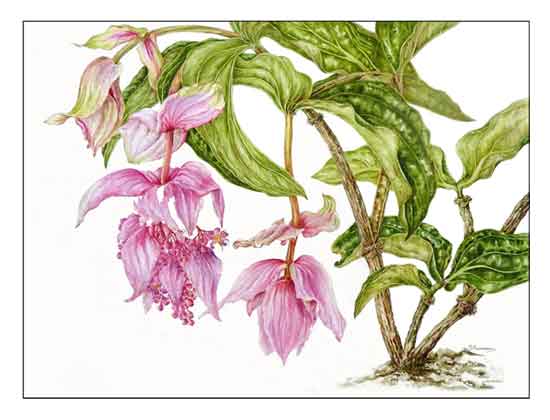 Gen info Gen info
- Medinilla magnifica is a species of epiphytic flowering plant in the family Melastomataceae, native to the Philippines.
- Medinilla was named in honor of José de Medinilla y Pineda, who was governor of Mauritius (Marianne Islands) in 1820.
(3)
- Manifica means 'magnificent', 'great', 'eminent', or 'distinguished'. (3)
- The plants has been awarded London's 'Royal Horticultural Society's Award of Merit.' (3)
Botany
Medinilla magnifica is an epiphytic erect shrub which grows to a maximum of 2.5 m tall. Matured leaves are dark green glossy, with leathery texture about 30cm long and 20–25 cm wide. Each leaf has 9–13 nerves which run from the mid rib to the margin or tip of the leaf. Matured leaves are dark green glossy, with leathery texture about 30cm long and 20–25 cm wide. Each leaf has 9–13 nerves which run from the mid rib to the margin or tip of the leaf. Stems are succulent and 4 angled. The weight of its heavy inflorescence causes it to appear drooping. Flowers are small pink to coral red which cluster together in a long dropping panicle and grow like bunches of grapes. Flower clusters are attached to large showy pink bracts. (4)
Distribution
- Native to the Philippines. (1)
- Also native to Java.
- Grows on tropical rain forest trees or on forest floor in partial shade.
C onstituents onstituents
- Study evaluated the phenolic compounds and hydrolysable tannin polyphenol oxidase from Medinilla magnifica. Distribution of the compound was simple phenols 19%, flavonoids 5%, hydrolysable tannins 69%, condensed tannins 9%. Simple phenols and phenolic acids were identified as phloroglucinol,
p-hydroxybenzoic acid, vanillic acid, protocatechuic acid, gallic acid (free and bound), syringic acid, trans-p-coumaric acid, trans-ferulic acid, and trans-caffeic acid.
(6)
- Preliminary phytochemical screening of leaves yielded tannins, saponins, and alkaloids. (see study below) (7)
Properties
Studies have suggested bioherbicidal and cytotoxic properties.
Parts used
Leaves, fruits.
Uses
Edibility
- Leaves and berries reportedly edible. (2)
Folkloric
- No reported folkloric medicinal use in the Philippines.
-
Ripening wound applied to wounds to promote healing.
Studies
• Bioherbicidal Activity / Leaves: Study evaluated the bioherbicidal activity of Medinilla magnifica leaf extract. Crude extract yielded 71.86 mg GAE/g of total phenolics and 29.58 mg QE/g of total flavonoids. Bioherbicidal activity using lettuce seed germination assay showed an LD50 (median lethal dose) of 64.69 ppm. The low LD50 suggests great potential against weeds. It inhibited the growth of Echinochloa crus-galli, Cyperus iria, and Ludwigia hyssopifolia. Results suggest the acid-hydrolyzed extract of M. magifica decreased chlorophyll production, resulting in reduced biomass of the test weeds. (5)
• Cytotoxicity Potential / Leaves: Cancer development is a multistage process that involves initiation, promotion, progression, invasion, and metastasis. Study evaluated the cytotoxic and growth inhibiting activity of crude extract of leaves of Medinilla magnifica. Preliminary screening yielded tannins, saponins, and alkaloids. Biologic tests used were Brine Shrimp Lethality Bioassay (BSLB) and Root Growth Assay. Results suggest the crude extract from leaves has potential cytotoxic property. (7)
Availability
- Wild-crafted.
- Ornamental cultivation.
- Seeds, plants in the cybermarket.
|

![]()





